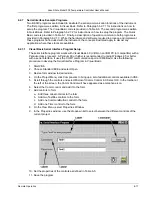
Lake Shore Model 332 Temperature Controller User’s Manual
Bus Control Commands (Continued)
Finally, Addressed Bus Control Commands are Multiline commands that must include the Model
332 listen address before the instrument responds. Only the addressed device responds to these
commands. The Model 332 recognizes three of the Addressed Bus Control Commands:
SDC (Selective Device Clear)
– The SDC command performs essentially the same function as the
DCL command except that only the addressed device responds.
GTL (Go To Local)
– The GTL command is used to remove instruments from the remote mode.
With some instruments, GTL also unlocks front panel controls if they were previously locked out
with the LLO command.
SPE (Serial Poll Enable)
and
SPD (Serial Poll Disable)
– Serial polling accesses the Service
Request Status Byte Register. This status register contains important operational information
from the unit requesting service. The SPD command ends the polling sequence.
6.1.2.2 Common
Commands
Common Commands are addressed commands which create commonalty between instruments on
the bus. All instruments that comply with the IEEE-488 1987 standard share these commands and
their format. Common commands all begin with an asterisk. They generally relate to “bus” and
“instrument” status and identification. Common query commands end with a question mark (?).
Model 332 common commands are detailed in Paragraph 6.3 and summarized in Table 6-8.
6.1.2.3
Device Specific Commands
Device specific commands are addressed commands. The Model 332 supports a variety of device
specific commands to program instruments remotely from a digital computer and to transfer
measurements to the computer. Most device specific commands perform functions also performed
from the front panel. Model 332 device specific commands are detailed in Paragraph 6.3 and
summarized in Table 6-8.
6.1.2.4 Message
Strings
A message string is a group of characters assembled to perform an interface function. There are
three types of message strings commands, queries and responses. The computer issues command
and query strings through user programs, the instrument issues responses. Two or more command
strings can be chained together in one communication but they must be separated by a semi-colon
(;). Only one query is permitted per communication but it can be chained to the end of a command.
The total communication string must not exceed 64 characters in length.
A command string is issued by the computer and instructs the instrument to perform a function or
change a parameter setting. When a command is issued, the computer is acting as ‘talker’ and the
instrument as ‘listener’. The format is:
<command mnemonic><space><parameter data><terminators>.
Command mnemonics and parameter data necessary for each one is described in Paragraph 6.3.
Terminators must be sent with every message string.
A query string is issued by the computer and instructs the instrument which response to send.
Queries are issued similar to commands with the computer acting as 'talker' and the instrument as
'listener'. The query format is:
<query mnemonic><?><space><parameter data><terminators>.
Query mnemonics are often the same as commands with the addition of a question mark.
Parameter data is often unnecessary when sending queries. Query mnemonics and parameter data
if necessary is described in Paragraph 6.3. Terminators must be sent with every message string.
Issuing a query does not initiate a response from the instrument.
A response string is sent by the instrument only when it is addressed as a 'talker' and the computer
becomes the 'listener'. The instrument will respond only to the last query it receives. The response
can be a reading value, status report or the present value of a parameter. Response data formats
are listed along with the associated queries in Paragraph 6.3.
Remote Operation
6-3
















































